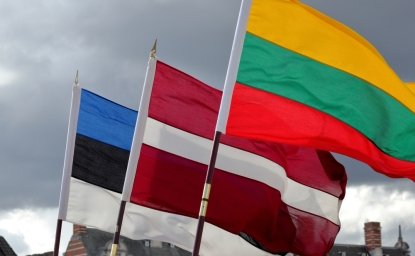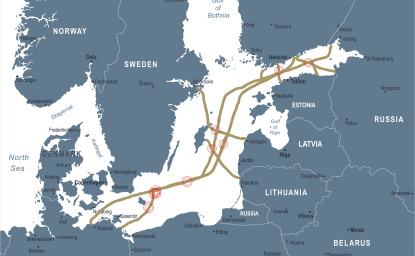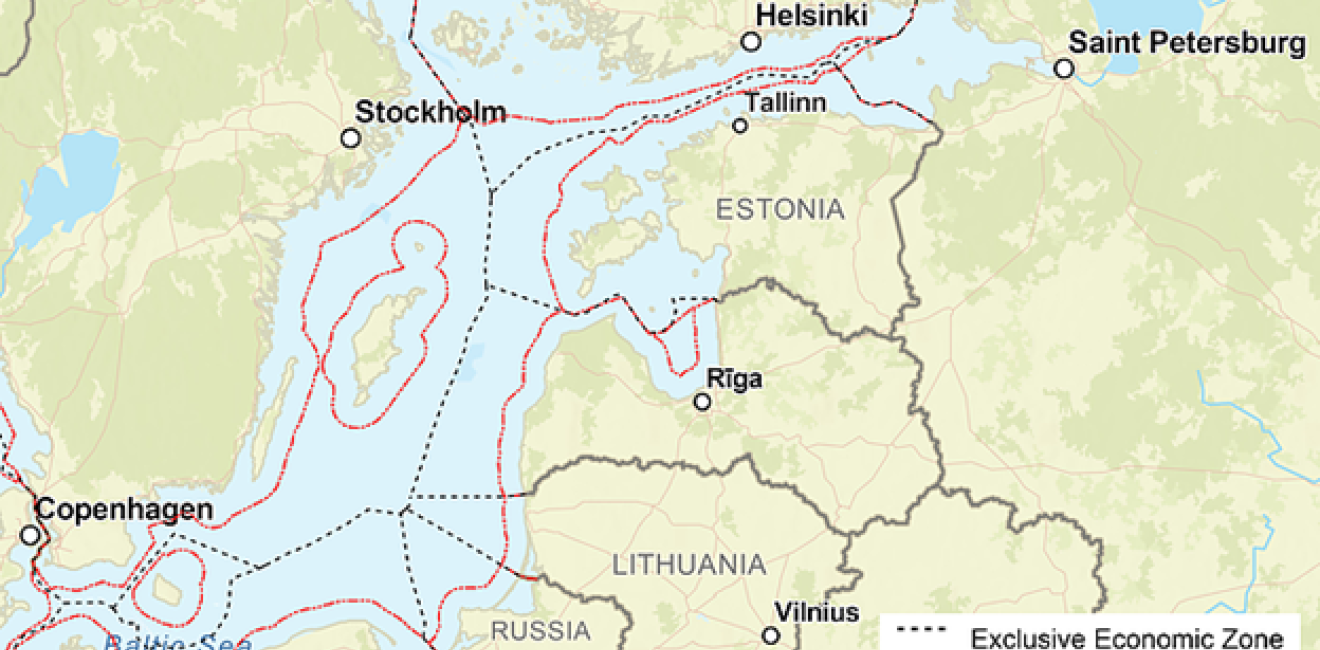On the evening of Tuesday, May 21, 2024, Russian media reported on a short, technical document posted online by the Russian Defence Ministry (MOD) regarding a maritime border project in the Baltic Sea.
In the memo, the Ministry was seeking approval for its proposal on a “draft list of geographical coordinates” that would help recalculate “baselines measuring the width of Russia’s territorial sea, mainland coastline and Baltic Sea islands.” By establishing “a missing straight baseline system,” the “maritime border” of the Russian Federation, would, according to the document, ultimately be altered. This redrawing of the boundary, pertaining specifically to the Kaliningrad region (near Baltiysk and Zelenograd) and the eastern Gulf of Finland (around several islands that the Finnish government ceded to the USSR in 1940), would allow Russia to “use these waters as internal.”
To the governments of Finland and Lithuania this news came as a complete surprise.
Importantly, the short “project” memo was published without the draft-proposal’s actual text or any technical appendices, so it is impossible to know how the borders might be redrawn.
The Ministry’s unilateral “declaratory action” regarding potential border changes (to be completed by January 2025) was justified on the grounds that the old Soviet baselines, codified in a 40-year-old resolution of the USSR Council of Ministers, had emanated from not only small-scale nautical charts, but also data as far back as the mid-20th century. The coordinates used thus might no longer correspond to current geographical realities.
Yet, by noon on Wednesday, May 22, 2024, the entire “project” referencing the “procurement of military security” had vanished from the portal's pages.
This was after a "military-diplomatic source" denied to the Russian news agencies, TASS, RIA Novosti, and Interfax that Russia had any plans “to re-examine the territorial waters of the Baltic Sea, the economic zones, the width of the coastal continental shelf or the alignment of the Russian state border.”
Vladimir Putin’s spokesperson, Dmitri Peskov, meanwhile, also had commented that there was nothing political to the paper, pushing responsibility for damage-control to the MOD.
Whether the deleted page (captured for posterity in a screenshot by Finnish newspaper Iltalehti) indicates the end of the MOD-plan remains unclear.
Meanwhile, the unfolding saga raises only more questions. Its timing coincides with the Finnish government’s proposed emergency legislation to block asylum seekers from entering the country via Russia, its signature of a declaration on strategic partnership with the UK, and with the start of Russia’s drills in the Southern Military District, simulating a launch of tactical nuclear weapons and responding “to provocative statements and threats of individual western officials.” In that context, what should be made of this incident?
Previously, in December 2021, the Russian MFA launched an aggressive diplomatic offensive with a list of sweeping security guarantees sought from the US and NATO (including the reversal of the Alliance’s long-standing “open door” policy). When Allies rebutted these demands, Russia used this as one of the legitimations for invading Ukraine. Was the border-change memo-affair a political Russian test of transatlantic resolve and cohesion?
Alternatively, was it perhaps the result of power games within the Russian administration to embarrass the MOD, as if the MOD acted overzealously in relation to the rest of Russian bureaucracy
It could also be that the web-upload happened accidentally––that some MOD entity tasked to recalculate with new technologies Russia's internal territorial maritime boundaries published something never meant to be displayed in the first place.
Be that as may, with its online publication of the border “project,” Moscow only further damaged the already tense relations between itself and its Western EU/NATO neighbors.
Lithuania’s Foreign Minister Gabriellus Landsbergis immediately called the incident another “hybrid Russian operation,” an “escalation against NATO and the EU” with the aim to spread “fear” and “uncertainty.” His Ministry later denounced the memo-affair as a “deliberate, targeted, escalatory provocation to intimidate neighbouring countries and their societies.” Micael Bydén, Sweden's supreme commander of the armed forces, was much more concrete but also alarmist, asserting Putin surely had “both eyes on Gotland,” his “goal to gain control of the Baltic Sea.”
The Finnish government’s reactions were more measured and restrained. Foreign Minister Elina Valtonen declared that the project looked like little more than a routine reassessment of maritime borders that might not even provoke adjustments. To be sure, small changes remain possible due to rising land / lower sea levels (e.g., around islands). As recently as 2017, Finland and Russia jointly undertook such standard boundary checks. Still, the “UN Convention on the Law of the Sea [UNCLOS] contains provisions on the definition of maritime zones of coastal states; including their revision. We assume,’ said Valtonen, “that Russia, as a party to the Convention, will act accordingly.”
Jukka Kopra, head of Finland's parliamentary defense committee, also saw “no great drama” in this affair; though he admitted that there was always the “risk” that when it came to borders and the "grey area," an agreement may not be reached. That was potentially problematic, but no immediate concern.
Finland’s President, Alexander Stubb, coolly weighed in on Twitter/X that Russia had “not contacted Finland about this matter.” This was noteworthy because if Russia’s project was just an innocent, technical check of geographic coordinates, it was all the more suspicious that Moscow had not informed its neighbors of its activities. Finland, so Stubb, was “closely monitoring the situation” and would for now “proceed as always: calmly and based on facts.”
Facts are indeed crucial at this moment of global upheaval—with Russia’s War in Ukraine newly intensified, the Israel-Palestine conflict ratcheted up another notch, the US media consumed with Trump’s trial and the 2024 presidential elections, the European Commission divided over their president’s re-election, the shooting of Slovakia’s prime minister, and the death of Iran’s president and foreign minister in a helicopter crash.
This week, the in-tray of US President Joe Biden and the other EU/NATO leaders could hardly be fuller. Putin, meanwhile, has doubtless returned from his most recent summit with Xi Jinping relatively reassured. On May 16, he and Xi proclaimed their firm opposition to the US on a host of security issues while indicating a "new era" of “strategic partnership,” underpinned by shared views on Taiwan, Ukraine, and North Korea and a desire to foster cooperation on finance and nuclear technologies.
In this context, we should not forget that a mere 8 months ago, the day after Hamas’ attack on Israel, it was Russian and Chinese ships that were linked to the damaged Finnish-Estonian Baltic connector pipeline and the destruction of two underwater data-cables linking Estonia to Finland and Sweden. Mischief-making (or accidents?) are nothing new in the Baltic Sea.
However small and insignificant the maritime border memo saga, the Russian authorities’ obfuscation and its incendiary timing (whether intentional or unintentional) means the West has to consider Russia’s next steps with vigilance. EU/NATO leaders and diplomats must maneuver through this latest event with sensitivity, pragmatism, and clarity.
It is relevant that the Kremlin has recently been irritated by Scandinavians’ talk of inspecting tankers transporting Russian oil through the Danish straits. So, the memo affair could be read as a specific political response, rather than either as a mere technical demarche or as a broader antagonistic signal.
Still, we must also remember that Vladimir Putin is a “history man.” The West would do well to keep in mind Putin’s warped readings of the past, as he works to revise the “greatest geopolitical catastrophe of the 20th century,” that of the collapse of the USSR.
In the 85th year since the Hitler Stalin-Pact, Putin is aware of Soviet Foreign Minister Vyacheslav Molotov’s words to his Estonian colleague Karl Selter on September 24, 1939: “Twenty years ago,” he said, “you made us sit in this Finnish ‘puddle”. You don’t think that this can last …. forever … The Soviet Union is now a great power whose interests need to be taken into consideration. I tell you––the Soviet Union needs enlargement of her security guarantees system; for this purpose, she needs an exit from the Baltic Sea.”
Molotov’s logic in 1939, coupled with Stalin’s demands in 1938 for border changes to meet Soviet Russia’s defense needs, differs little from Putin’s thoughts in 2022 or in 2024.
Seen in this light, the latest incident in the Baltic Sea is hardly happenstance. It undoubtedly fits with the revanchist hybrid warfare tactics of Putin’s Russia and its broader non-linear warfare strategy to weaken and ultimately destroy the Euro-Atlantic community. The Kremlin, we must realize, considers itself already in all-out war with the liberal world (which in 2019 Putin declared “obsolete”).
Attempts to sow confusion and uncertainty, to undercut civilian resilience, and to distract and provoke have been the hallmark of Russia’s recent modus operandi.
The Baltic Sea states and their allies need to watch Russia’s next moves with sangfroid and unity, drawing red lines to insist upon the UN’s and OSCE’s principles of the inviolability of borders and the freedoms granted by the United Nations Convention on the Law of the Sea. Now is not the time for nerves to falter.
Rhetorical restraint, measured deterrence, and strong defenses continue be vital to manage and confront Russian aggression.
Author

Professor, London School of Economics and Political Sciences

Global Europe Program
The Global Europe Program is focused on Europe’s capabilities, and how it engages on critical global issues. We investigate European approaches to critical global issues. We examine Europe’s relations with Russia and Eurasia, China and the Indo-Pacific, the Middle East and Africa. Our initiatives include “Ukraine in Europe”—an examination of what it will take to make Ukraine’s European future a reality. But we also examine the role of NATO, the European Union and the OSCE, Europe’s energy security, transatlantic trade disputes, and challenges to democracy. The Global Europe Program’s staff, scholars-in-residence, and Global Fellows participate in seminars, policy study groups, and international conferences to provide analytical recommendations to policy makers and the media. Read more


Polar Institute
Since its inception in 2017, the Polar Institute has become a premier forum for discussion and policy analysis of Arctic and Antarctic issues, and is known in Washington, DC and elsewhere as the Arctic Public Square. The Institute holistically studies the central policy issues facing these regions—with an emphasis on Arctic governance, climate change, economic development, scientific research, security, and Indigenous communities—and communicates trusted analysis to policymakers and other stakeholders. Read more


Kennan Institute
After more than 50 years as a vital part of the Wilson Center legacy, the Kennan Institute has become an independent think tank. You can find the current website for the Kennan Institute at kennaninstitute.org. Please look for future announcements about partnership activities between the Wilson Center and the Kennan Institute at Wilson Center Press Room. The Kennan Institute is the premier US center for advanced research on Eurasia and the oldest and largest regional program at the Woodrow Wilson International Center for Scholars. The Kennan Institute is committed to improving American understanding of Russia, Ukraine, Central Asia, the South Caucasus, and the surrounding region through research and exchange. Read more

Explore More
Browse Insights & Analysis
Baltic States’ Contributions to Ukraine

The OSCE is a Good Value for America


